BSc Cloud Computing: Data Analysis and Visualization Report
VerifiedAdded on 2022/12/29
|16
|2397
|97
Report
AI Summary
This report presents a data analysis of COVID-19 infection rates in the United Kingdom, comparing white residents and BAME populations. The analysis uses a dataset of 50 individuals from each group to determine the subtypes of patients most affected by the pandemic. It includes descriptive statistics, hypothesis testing (including one-sample t-tests), and correlation analysis to evaluate the differences in infection rates. The study sets up hypotheses to assess the variations in outcomes between communities and uses techniques like ANOVA and correlation to present the results. The practical application involves testing hypotheses at different significance levels and interpreting the results, concluding that there are major disparities between the infection rates of white and BAME populations, although there is a link between infection prevalence in both groups.

Data Analysis and Visualization
Paraphrase This Document
Need a fresh take? Get an instant paraphrase of this document with our AI Paraphraser
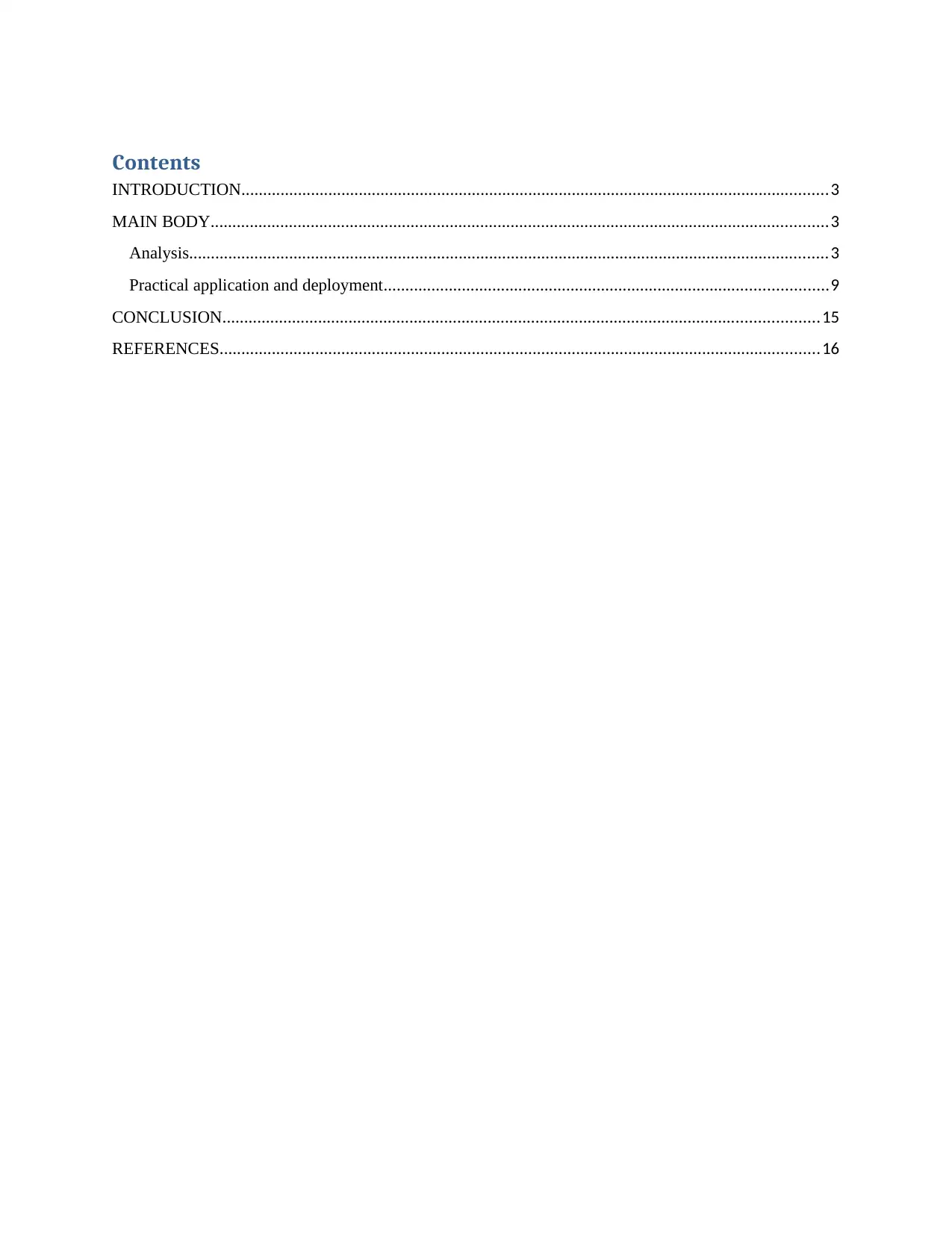
Contents
INTRODUCTION.......................................................................................................................................3
MAIN BODY..............................................................................................................................................3
Analysis...................................................................................................................................................3
Practical application and deployment......................................................................................................9
CONCLUSION.........................................................................................................................................15
REFERENCES..........................................................................................................................................16
INTRODUCTION.......................................................................................................................................3
MAIN BODY..............................................................................................................................................3
Analysis...................................................................................................................................................3
Practical application and deployment......................................................................................................9
CONCLUSION.........................................................................................................................................15
REFERENCES..........................................................................................................................................16
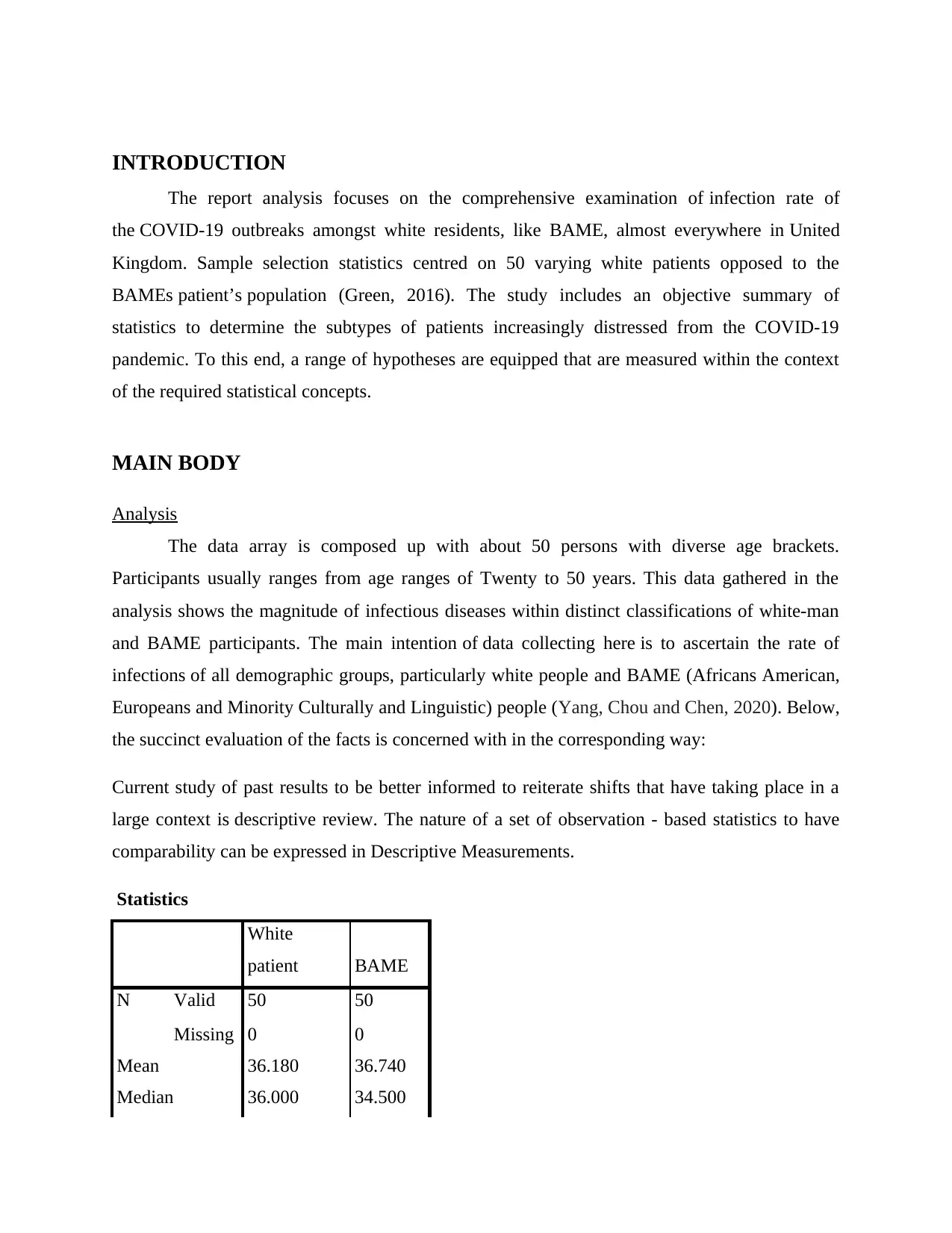
INTRODUCTION
The report analysis focuses on the comprehensive examination of infection rate of
the COVID-19 outbreaks amongst white residents, like BAME, almost everywhere in United
Kingdom. Sample selection statistics centred on 50 varying white patients opposed to the
BAMEs patient’s population (Green, 2016). The study includes an objective summary of
statistics to determine the subtypes of patients increasingly distressed from the COVID-19
pandemic. To this end, a range of hypotheses are equipped that are measured within the context
of the required statistical concepts.
MAIN BODY
Analysis
The data array is composed up with about 50 persons with diverse age brackets.
Participants usually ranges from age ranges of Twenty to 50 years. This data gathered in the
analysis shows the magnitude of infectious diseases within distinct classifications of white-man
and BAME participants. The main intention of data collecting here is to ascertain the rate of
infections of all demographic groups, particularly white people and BAME (Africans American,
Europeans and Minority Culturally and Linguistic) people (Yang, Chou and Chen, 2020). Below,
the succinct evaluation of the facts is concerned with in the corresponding way:
Current study of past results to be better informed to reiterate shifts that have taking place in a
large context is descriptive review. The nature of a set of observation - based statistics to have
comparability can be expressed in Descriptive Measurements.
Statistics
White
patient BAME
N Valid 50 50
Missing 0 0
Mean 36.180 36.740
Median 36.000 34.500
The report analysis focuses on the comprehensive examination of infection rate of
the COVID-19 outbreaks amongst white residents, like BAME, almost everywhere in United
Kingdom. Sample selection statistics centred on 50 varying white patients opposed to the
BAMEs patient’s population (Green, 2016). The study includes an objective summary of
statistics to determine the subtypes of patients increasingly distressed from the COVID-19
pandemic. To this end, a range of hypotheses are equipped that are measured within the context
of the required statistical concepts.
MAIN BODY
Analysis
The data array is composed up with about 50 persons with diverse age brackets.
Participants usually ranges from age ranges of Twenty to 50 years. This data gathered in the
analysis shows the magnitude of infectious diseases within distinct classifications of white-man
and BAME participants. The main intention of data collecting here is to ascertain the rate of
infections of all demographic groups, particularly white people and BAME (Africans American,
Europeans and Minority Culturally and Linguistic) people (Yang, Chou and Chen, 2020). Below,
the succinct evaluation of the facts is concerned with in the corresponding way:
Current study of past results to be better informed to reiterate shifts that have taking place in a
large context is descriptive review. The nature of a set of observation - based statistics to have
comparability can be expressed in Descriptive Measurements.
Statistics
White
patient BAME
N Valid 50 50
Missing 0 0
Mean 36.180 36.740
Median 36.000 34.500
⊘ This is a preview!⊘
Do you want full access?
Subscribe today to unlock all pages.

Trusted by 1+ million students worldwide
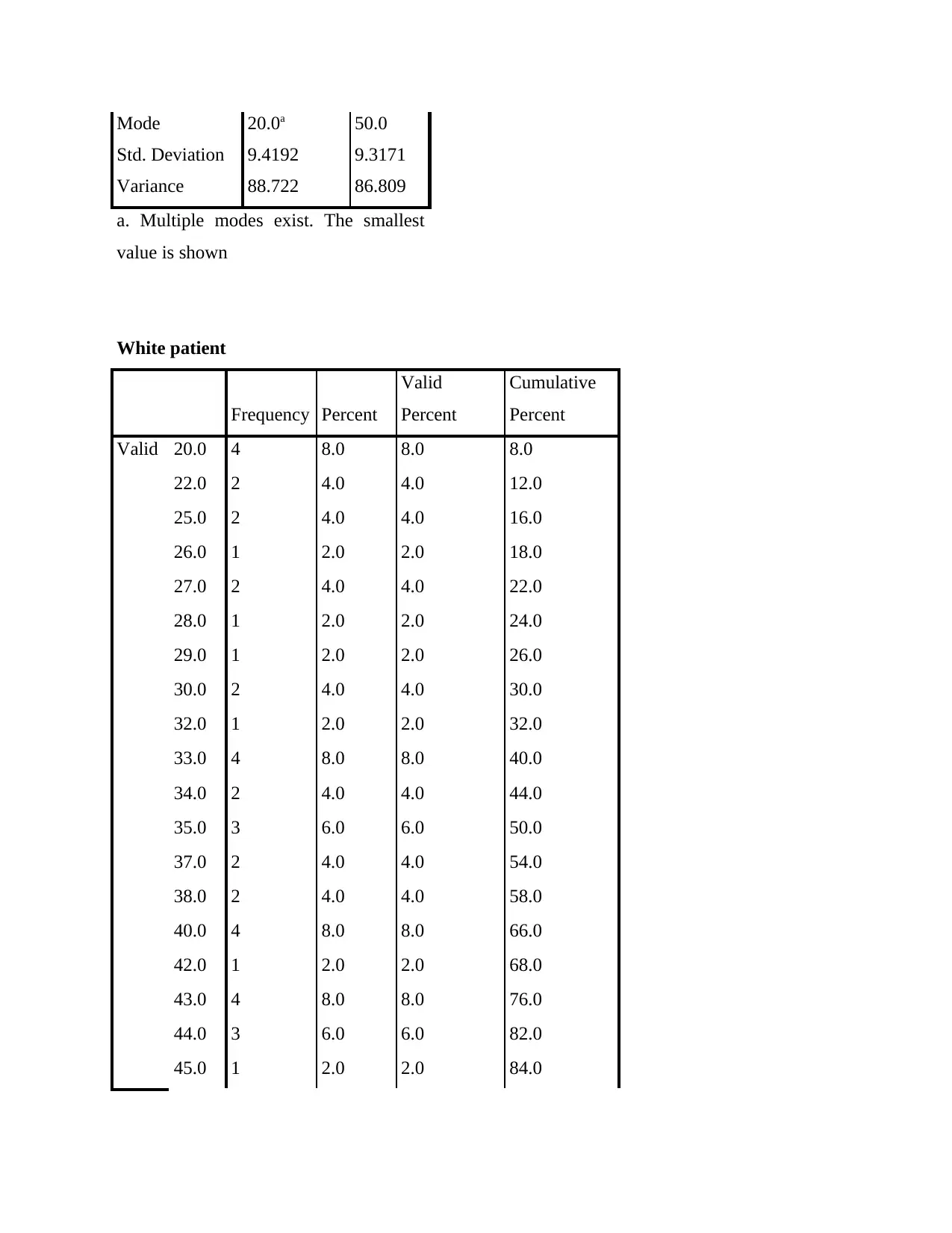
Mode 20.0a 50.0
Std. Deviation 9.4192 9.3171
Variance 88.722 86.809
a. Multiple modes exist. The smallest
value is shown
White patient
Frequency Percent
Valid
Percent
Cumulative
Percent
Valid 20.0 4 8.0 8.0 8.0
22.0 2 4.0 4.0 12.0
25.0 2 4.0 4.0 16.0
26.0 1 2.0 2.0 18.0
27.0 2 4.0 4.0 22.0
28.0 1 2.0 2.0 24.0
29.0 1 2.0 2.0 26.0
30.0 2 4.0 4.0 30.0
32.0 1 2.0 2.0 32.0
33.0 4 8.0 8.0 40.0
34.0 2 4.0 4.0 44.0
35.0 3 6.0 6.0 50.0
37.0 2 4.0 4.0 54.0
38.0 2 4.0 4.0 58.0
40.0 4 8.0 8.0 66.0
42.0 1 2.0 2.0 68.0
43.0 4 8.0 8.0 76.0
44.0 3 6.0 6.0 82.0
45.0 1 2.0 2.0 84.0
Std. Deviation 9.4192 9.3171
Variance 88.722 86.809
a. Multiple modes exist. The smallest
value is shown
White patient
Frequency Percent
Valid
Percent
Cumulative
Percent
Valid 20.0 4 8.0 8.0 8.0
22.0 2 4.0 4.0 12.0
25.0 2 4.0 4.0 16.0
26.0 1 2.0 2.0 18.0
27.0 2 4.0 4.0 22.0
28.0 1 2.0 2.0 24.0
29.0 1 2.0 2.0 26.0
30.0 2 4.0 4.0 30.0
32.0 1 2.0 2.0 32.0
33.0 4 8.0 8.0 40.0
34.0 2 4.0 4.0 44.0
35.0 3 6.0 6.0 50.0
37.0 2 4.0 4.0 54.0
38.0 2 4.0 4.0 58.0
40.0 4 8.0 8.0 66.0
42.0 1 2.0 2.0 68.0
43.0 4 8.0 8.0 76.0
44.0 3 6.0 6.0 82.0
45.0 1 2.0 2.0 84.0
Paraphrase This Document
Need a fresh take? Get an instant paraphrase of this document with our AI Paraphraser
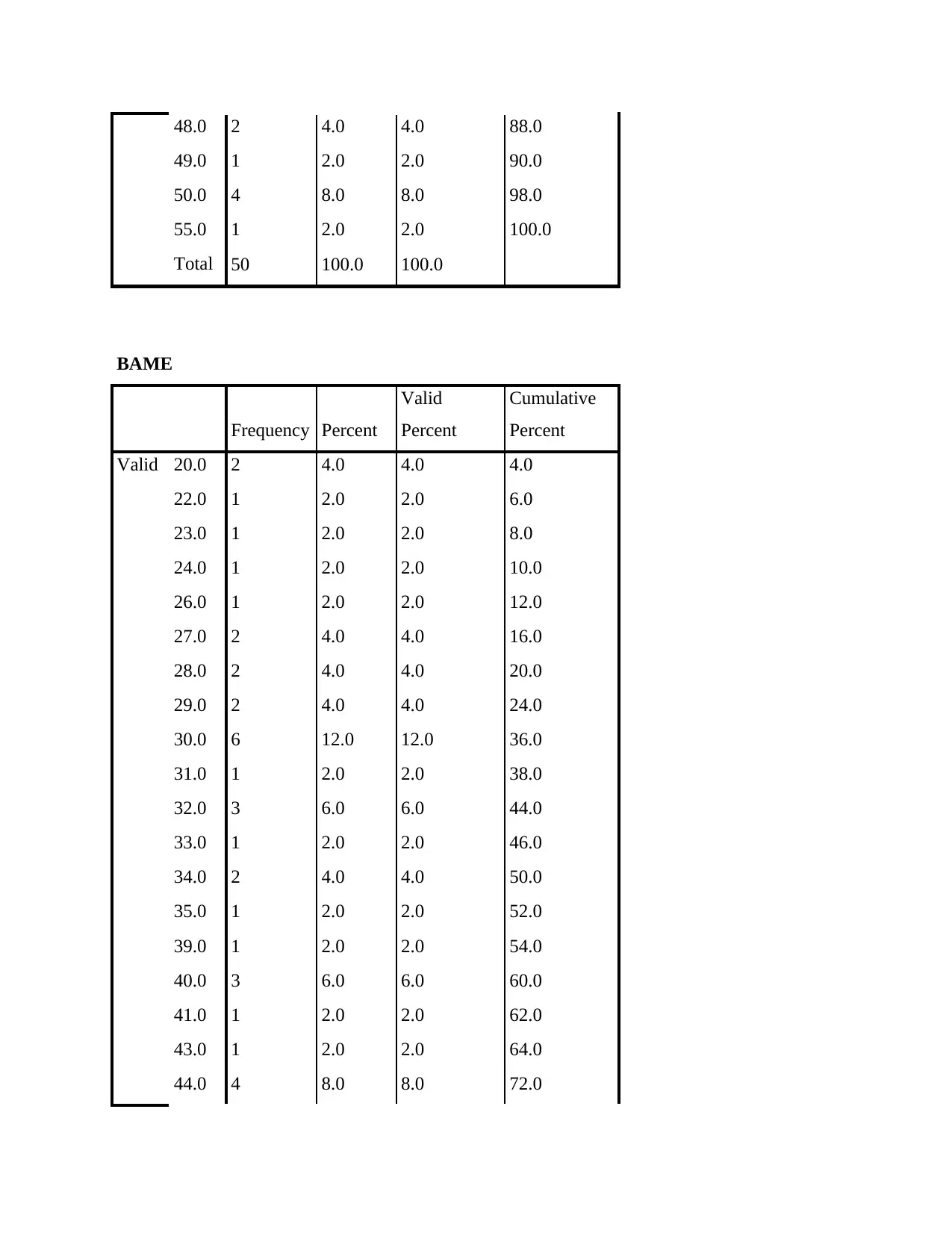
48.0 2 4.0 4.0 88.0
49.0 1 2.0 2.0 90.0
50.0 4 8.0 8.0 98.0
55.0 1 2.0 2.0 100.0
Total 50 100.0 100.0
BAME
Frequency Percent
Valid
Percent
Cumulative
Percent
Valid 20.0 2 4.0 4.0 4.0
22.0 1 2.0 2.0 6.0
23.0 1 2.0 2.0 8.0
24.0 1 2.0 2.0 10.0
26.0 1 2.0 2.0 12.0
27.0 2 4.0 4.0 16.0
28.0 2 4.0 4.0 20.0
29.0 2 4.0 4.0 24.0
30.0 6 12.0 12.0 36.0
31.0 1 2.0 2.0 38.0
32.0 3 6.0 6.0 44.0
33.0 1 2.0 2.0 46.0
34.0 2 4.0 4.0 50.0
35.0 1 2.0 2.0 52.0
39.0 1 2.0 2.0 54.0
40.0 3 6.0 6.0 60.0
41.0 1 2.0 2.0 62.0
43.0 1 2.0 2.0 64.0
44.0 4 8.0 8.0 72.0
49.0 1 2.0 2.0 90.0
50.0 4 8.0 8.0 98.0
55.0 1 2.0 2.0 100.0
Total 50 100.0 100.0
BAME
Frequency Percent
Valid
Percent
Cumulative
Percent
Valid 20.0 2 4.0 4.0 4.0
22.0 1 2.0 2.0 6.0
23.0 1 2.0 2.0 8.0
24.0 1 2.0 2.0 10.0
26.0 1 2.0 2.0 12.0
27.0 2 4.0 4.0 16.0
28.0 2 4.0 4.0 20.0
29.0 2 4.0 4.0 24.0
30.0 6 12.0 12.0 36.0
31.0 1 2.0 2.0 38.0
32.0 3 6.0 6.0 44.0
33.0 1 2.0 2.0 46.0
34.0 2 4.0 4.0 50.0
35.0 1 2.0 2.0 52.0
39.0 1 2.0 2.0 54.0
40.0 3 6.0 6.0 60.0
41.0 1 2.0 2.0 62.0
43.0 1 2.0 2.0 64.0
44.0 4 8.0 8.0 72.0
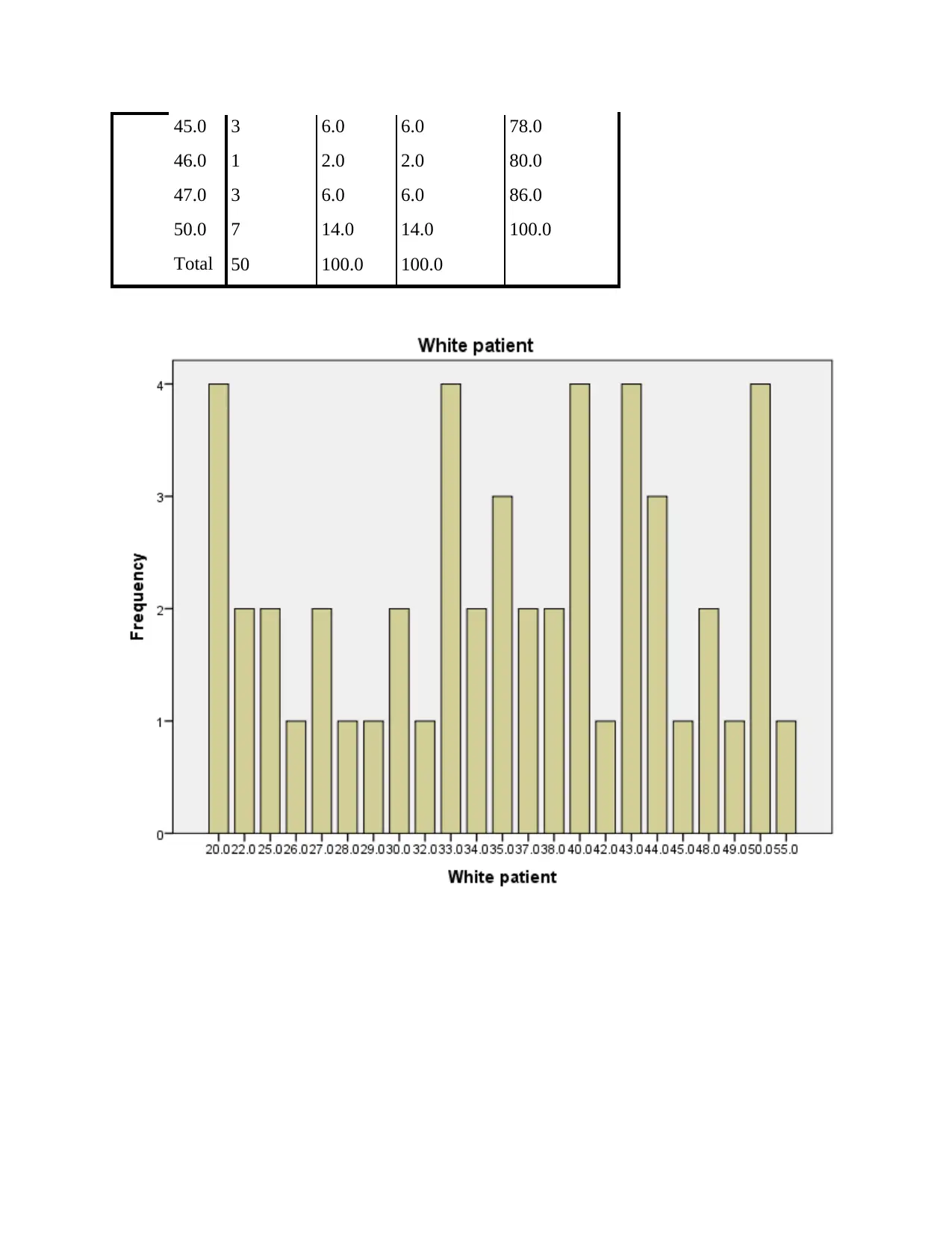
45.0 3 6.0 6.0 78.0
46.0 1 2.0 2.0 80.0
47.0 3 6.0 6.0 86.0
50.0 7 14.0 14.0 100.0
Total 50 100.0 100.0
46.0 1 2.0 2.0 80.0
47.0 3 6.0 6.0 86.0
50.0 7 14.0 14.0 100.0
Total 50 100.0 100.0
⊘ This is a preview!⊘
Do you want full access?
Subscribe today to unlock all pages.

Trusted by 1+ million students worldwide
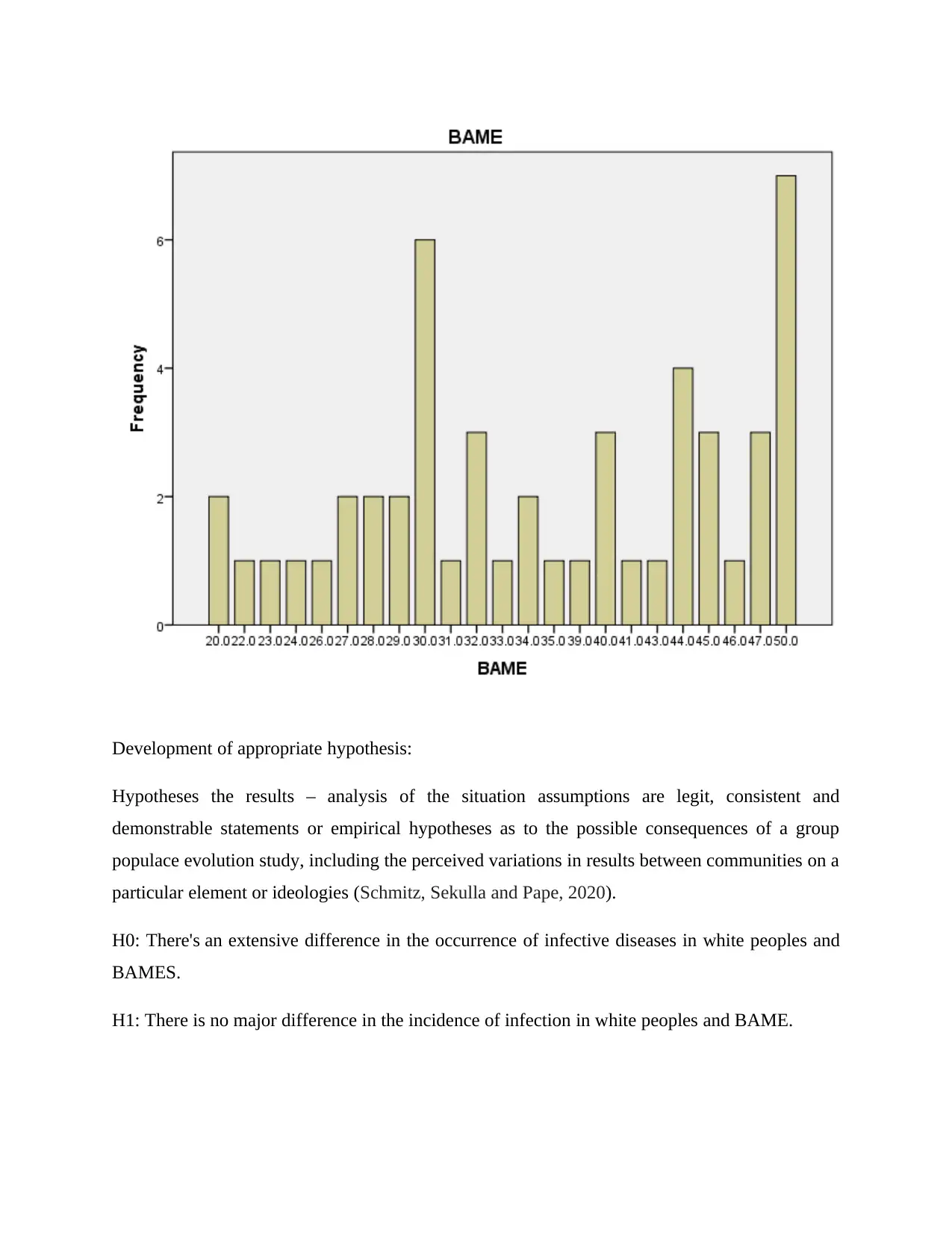
Development of appropriate hypothesis:
Hypotheses the results – analysis of the situation assumptions are legit, consistent and
demonstrable statements or empirical hypotheses as to the possible consequences of a group
populace evolution study, including the perceived variations in results between communities on a
particular element or ideologies (Schmitz, Sekulla and Pape, 2020).
H0: There's an extensive difference in the occurrence of infective diseases in white peoples and
BAMES.
H1: There is no major difference in the incidence of infection in white peoples and BAME.
Hypotheses the results – analysis of the situation assumptions are legit, consistent and
demonstrable statements or empirical hypotheses as to the possible consequences of a group
populace evolution study, including the perceived variations in results between communities on a
particular element or ideologies (Schmitz, Sekulla and Pape, 2020).
H0: There's an extensive difference in the occurrence of infective diseases in white peoples and
BAMES.
H1: There is no major difference in the incidence of infection in white peoples and BAME.
Paraphrase This Document
Need a fresh take? Get an instant paraphrase of this document with our AI Paraphraser
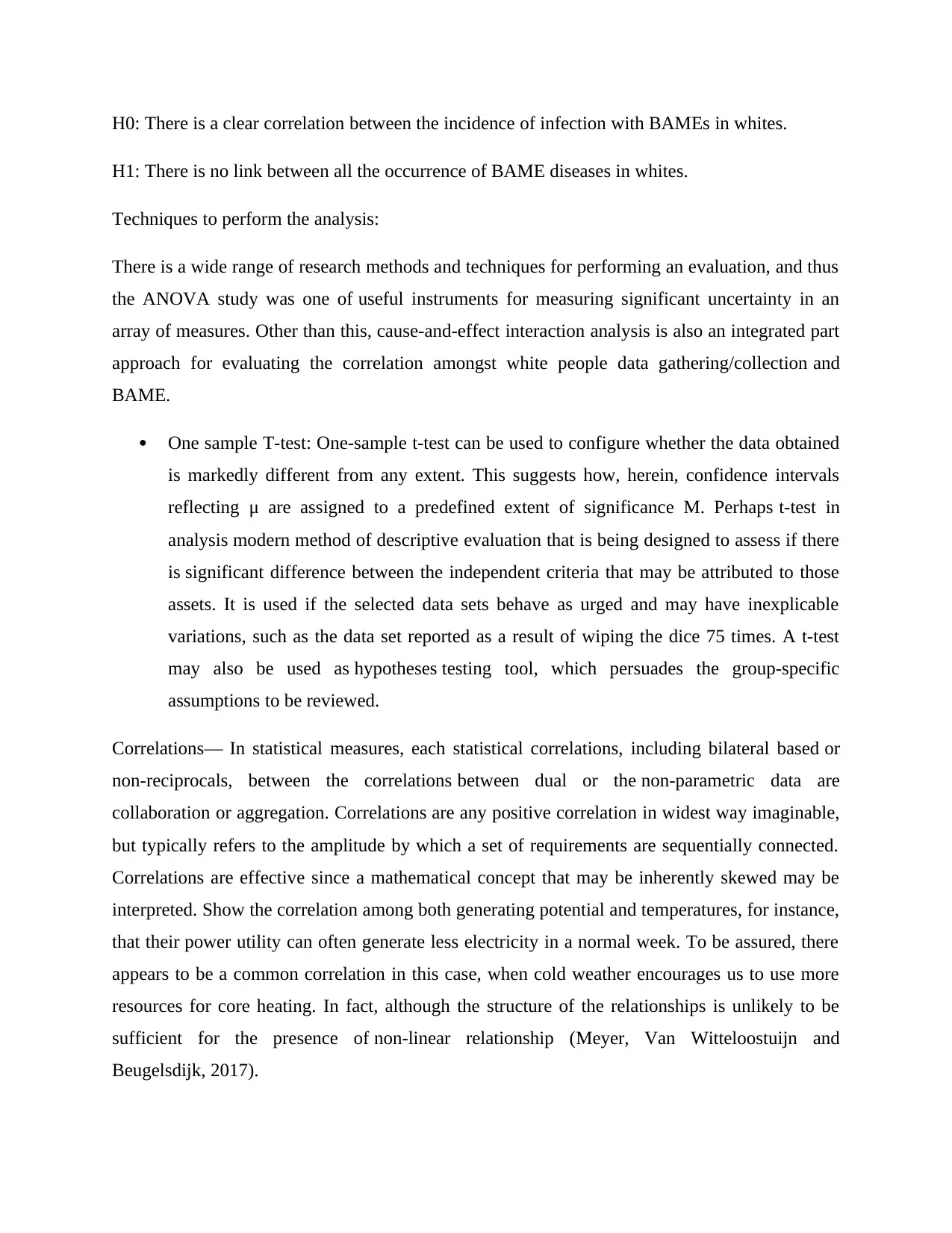
H0: There is a clear correlation between the incidence of infection with BAMEs in whites.
H1: There is no link between all the occurrence of BAME diseases in whites.
Techniques to perform the analysis:
There is a wide range of research methods and techniques for performing an evaluation, and thus
the ANOVA study was one of useful instruments for measuring significant uncertainty in an
array of measures. Other than this, cause-and-effect interaction analysis is also an integrated part
approach for evaluating the correlation amongst white people data gathering/collection and
BAME.
One sample T-test: One-sample t-test can be used to configure whether the data obtained
is markedly different from any extent. This suggests how, herein, confidence intervals
reflecting μ are assigned to a predefined extent of significance M. Perhaps t-test in
analysis modern method of descriptive evaluation that is being designed to assess if there
is significant difference between the independent criteria that may be attributed to those
assets. It is used if the selected data sets behave as urged and may have inexplicable
variations, such as the data set reported as a result of wiping the dice 75 times. A t-test
may also be used as hypotheses testing tool, which persuades the group-specific
assumptions to be reviewed.
Correlations— In statistical measures, each statistical correlations, including bilateral based or
non-reciprocals, between the correlations between dual or the non-parametric data are
collaboration or aggregation. Correlations are any positive correlation in widest way imaginable,
but typically refers to the amplitude by which a set of requirements are sequentially connected.
Correlations are effective since a mathematical concept that may be inherently skewed may be
interpreted. Show the correlation among both generating potential and temperatures, for instance,
that their power utility can often generate less electricity in a normal week. To be assured, there
appears to be a common correlation in this case, when cold weather encourages us to use more
resources for core heating. In fact, although the structure of the relationships is unlikely to be
sufficient for the presence of non-linear relationship (Meyer, Van Witteloostuijn and
Beugelsdijk, 2017).
H1: There is no link between all the occurrence of BAME diseases in whites.
Techniques to perform the analysis:
There is a wide range of research methods and techniques for performing an evaluation, and thus
the ANOVA study was one of useful instruments for measuring significant uncertainty in an
array of measures. Other than this, cause-and-effect interaction analysis is also an integrated part
approach for evaluating the correlation amongst white people data gathering/collection and
BAME.
One sample T-test: One-sample t-test can be used to configure whether the data obtained
is markedly different from any extent. This suggests how, herein, confidence intervals
reflecting μ are assigned to a predefined extent of significance M. Perhaps t-test in
analysis modern method of descriptive evaluation that is being designed to assess if there
is significant difference between the independent criteria that may be attributed to those
assets. It is used if the selected data sets behave as urged and may have inexplicable
variations, such as the data set reported as a result of wiping the dice 75 times. A t-test
may also be used as hypotheses testing tool, which persuades the group-specific
assumptions to be reviewed.
Correlations— In statistical measures, each statistical correlations, including bilateral based or
non-reciprocals, between the correlations between dual or the non-parametric data are
collaboration or aggregation. Correlations are any positive correlation in widest way imaginable,
but typically refers to the amplitude by which a set of requirements are sequentially connected.
Correlations are effective since a mathematical concept that may be inherently skewed may be
interpreted. Show the correlation among both generating potential and temperatures, for instance,
that their power utility can often generate less electricity in a normal week. To be assured, there
appears to be a common correlation in this case, when cold weather encourages us to use more
resources for core heating. In fact, although the structure of the relationships is unlikely to be
sufficient for the presence of non-linear relationship (Meyer, Van Witteloostuijn and
Beugelsdijk, 2017).
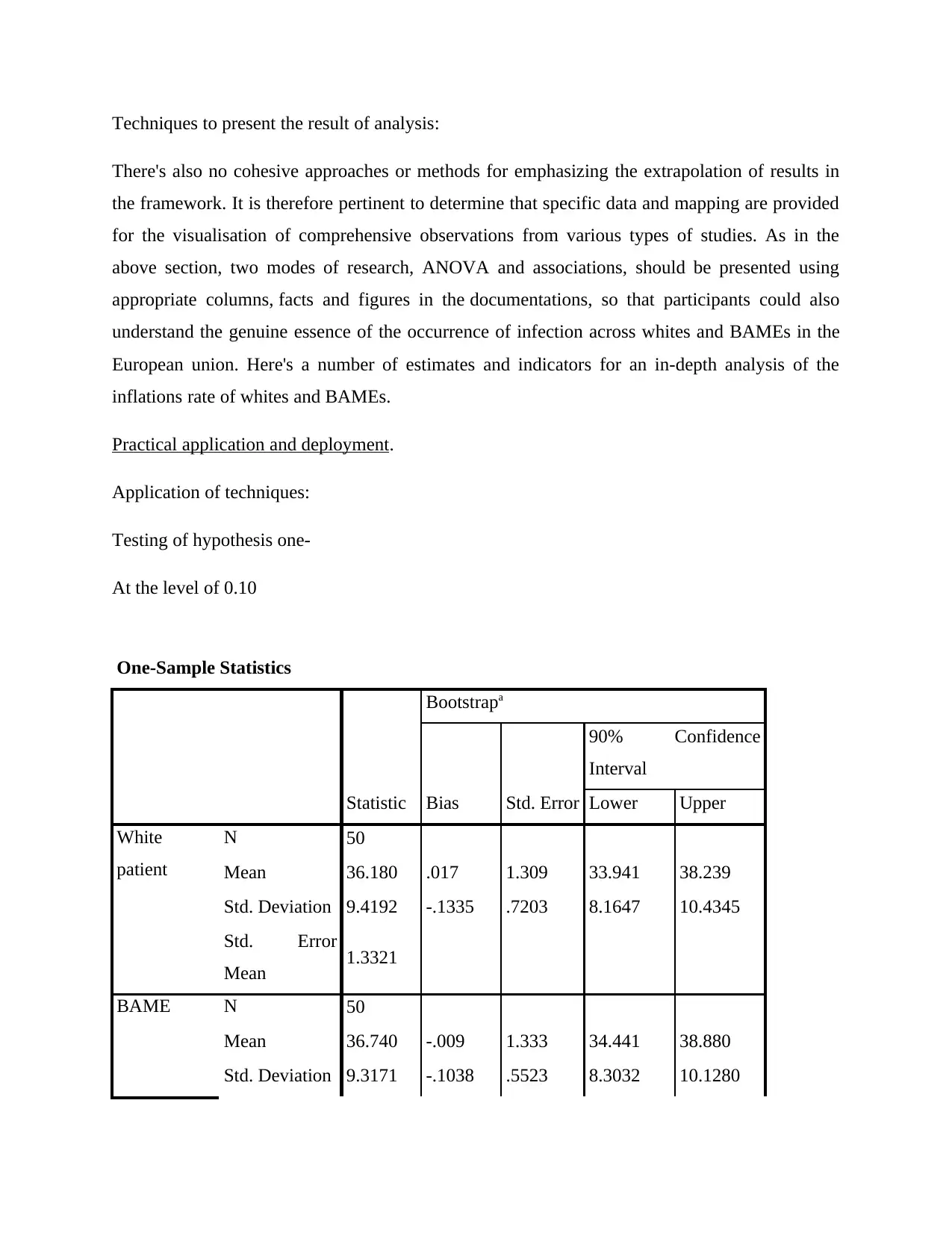
Techniques to present the result of analysis:
There's also no cohesive approaches or methods for emphasizing the extrapolation of results in
the framework. It is therefore pertinent to determine that specific data and mapping are provided
for the visualisation of comprehensive observations from various types of studies. As in the
above section, two modes of research, ANOVA and associations, should be presented using
appropriate columns, facts and figures in the documentations, so that participants could also
understand the genuine essence of the occurrence of infection across whites and BAMEs in the
European union. Here's a number of estimates and indicators for an in-depth analysis of the
inflations rate of whites and BAMEs.
Practical application and deployment.
Application of techniques:
Testing of hypothesis one-
At the level of 0.10
One-Sample Statistics
Statistic
Bootstrapa
Bias Std. Error
90% Confidence
Interval
Lower Upper
White
patient
N 50
Mean 36.180 .017 1.309 33.941 38.239
Std. Deviation 9.4192 -.1335 .7203 8.1647 10.4345
Std. Error
Mean 1.3321
BAME N 50
Mean 36.740 -.009 1.333 34.441 38.880
Std. Deviation 9.3171 -.1038 .5523 8.3032 10.1280
There's also no cohesive approaches or methods for emphasizing the extrapolation of results in
the framework. It is therefore pertinent to determine that specific data and mapping are provided
for the visualisation of comprehensive observations from various types of studies. As in the
above section, two modes of research, ANOVA and associations, should be presented using
appropriate columns, facts and figures in the documentations, so that participants could also
understand the genuine essence of the occurrence of infection across whites and BAMEs in the
European union. Here's a number of estimates and indicators for an in-depth analysis of the
inflations rate of whites and BAMEs.
Practical application and deployment.
Application of techniques:
Testing of hypothesis one-
At the level of 0.10
One-Sample Statistics
Statistic
Bootstrapa
Bias Std. Error
90% Confidence
Interval
Lower Upper
White
patient
N 50
Mean 36.180 .017 1.309 33.941 38.239
Std. Deviation 9.4192 -.1335 .7203 8.1647 10.4345
Std. Error
Mean 1.3321
BAME N 50
Mean 36.740 -.009 1.333 34.441 38.880
Std. Deviation 9.3171 -.1038 .5523 8.3032 10.1280
⊘ This is a preview!⊘
Do you want full access?
Subscribe today to unlock all pages.

Trusted by 1+ million students worldwide
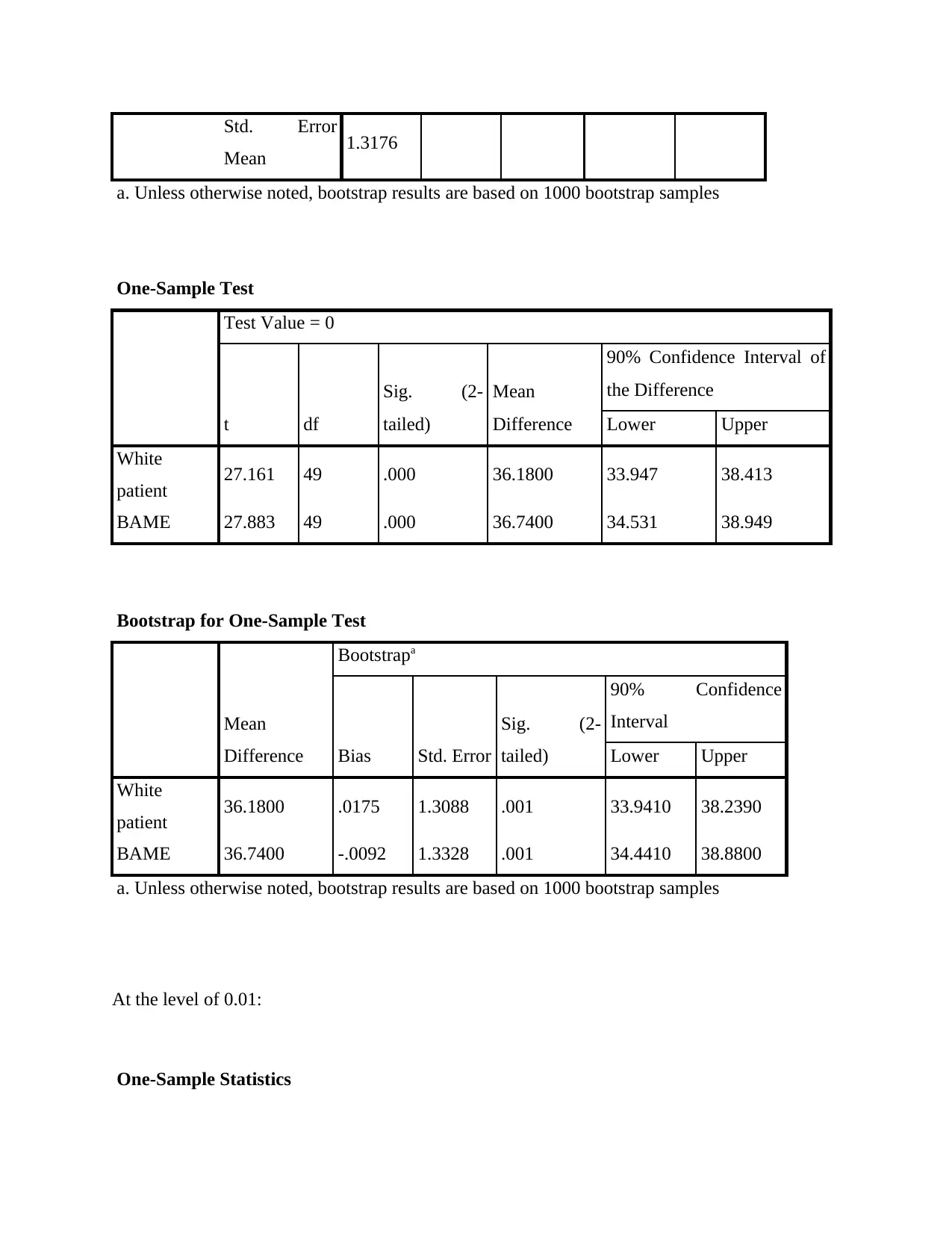
Std. Error
Mean 1.3176
a. Unless otherwise noted, bootstrap results are based on 1000 bootstrap samples
One-Sample Test
Test Value = 0
t df
Sig. (2-
tailed)
Mean
Difference
90% Confidence Interval of
the Difference
Lower Upper
White
patient 27.161 49 .000 36.1800 33.947 38.413
BAME 27.883 49 .000 36.7400 34.531 38.949
Bootstrap for One-Sample Test
Mean
Difference
Bootstrapa
Bias Std. Error
Sig. (2-
tailed)
90% Confidence
Interval
Lower Upper
White
patient 36.1800 .0175 1.3088 .001 33.9410 38.2390
BAME 36.7400 -.0092 1.3328 .001 34.4410 38.8800
a. Unless otherwise noted, bootstrap results are based on 1000 bootstrap samples
At the level of 0.01:
One-Sample Statistics
Mean 1.3176
a. Unless otherwise noted, bootstrap results are based on 1000 bootstrap samples
One-Sample Test
Test Value = 0
t df
Sig. (2-
tailed)
Mean
Difference
90% Confidence Interval of
the Difference
Lower Upper
White
patient 27.161 49 .000 36.1800 33.947 38.413
BAME 27.883 49 .000 36.7400 34.531 38.949
Bootstrap for One-Sample Test
Mean
Difference
Bootstrapa
Bias Std. Error
Sig. (2-
tailed)
90% Confidence
Interval
Lower Upper
White
patient 36.1800 .0175 1.3088 .001 33.9410 38.2390
BAME 36.7400 -.0092 1.3328 .001 34.4410 38.8800
a. Unless otherwise noted, bootstrap results are based on 1000 bootstrap samples
At the level of 0.01:
One-Sample Statistics
Paraphrase This Document
Need a fresh take? Get an instant paraphrase of this document with our AI Paraphraser
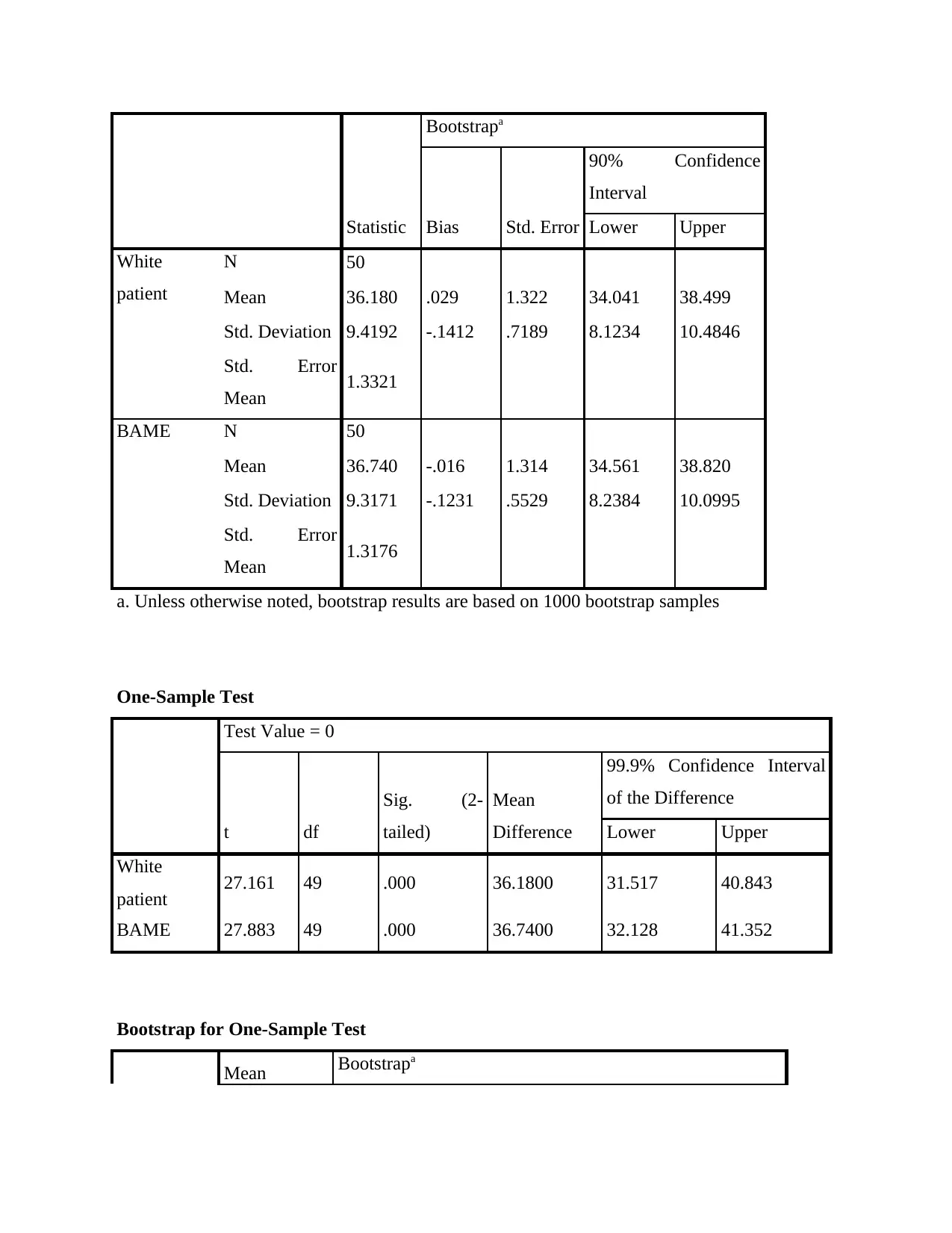
Statistic
Bootstrapa
Bias Std. Error
90% Confidence
Interval
Lower Upper
White
patient
N 50
Mean 36.180 .029 1.322 34.041 38.499
Std. Deviation 9.4192 -.1412 .7189 8.1234 10.4846
Std. Error
Mean 1.3321
BAME N 50
Mean 36.740 -.016 1.314 34.561 38.820
Std. Deviation 9.3171 -.1231 .5529 8.2384 10.0995
Std. Error
Mean 1.3176
a. Unless otherwise noted, bootstrap results are based on 1000 bootstrap samples
One-Sample Test
Test Value = 0
t df
Sig. (2-
tailed)
Mean
Difference
99.9% Confidence Interval
of the Difference
Lower Upper
White
patient 27.161 49 .000 36.1800 31.517 40.843
BAME 27.883 49 .000 36.7400 32.128 41.352
Bootstrap for One-Sample Test
Mean Bootstrapa
Bootstrapa
Bias Std. Error
90% Confidence
Interval
Lower Upper
White
patient
N 50
Mean 36.180 .029 1.322 34.041 38.499
Std. Deviation 9.4192 -.1412 .7189 8.1234 10.4846
Std. Error
Mean 1.3321
BAME N 50
Mean 36.740 -.016 1.314 34.561 38.820
Std. Deviation 9.3171 -.1231 .5529 8.2384 10.0995
Std. Error
Mean 1.3176
a. Unless otherwise noted, bootstrap results are based on 1000 bootstrap samples
One-Sample Test
Test Value = 0
t df
Sig. (2-
tailed)
Mean
Difference
99.9% Confidence Interval
of the Difference
Lower Upper
White
patient 27.161 49 .000 36.1800 31.517 40.843
BAME 27.883 49 .000 36.7400 32.128 41.352
Bootstrap for One-Sample Test
Mean Bootstrapa
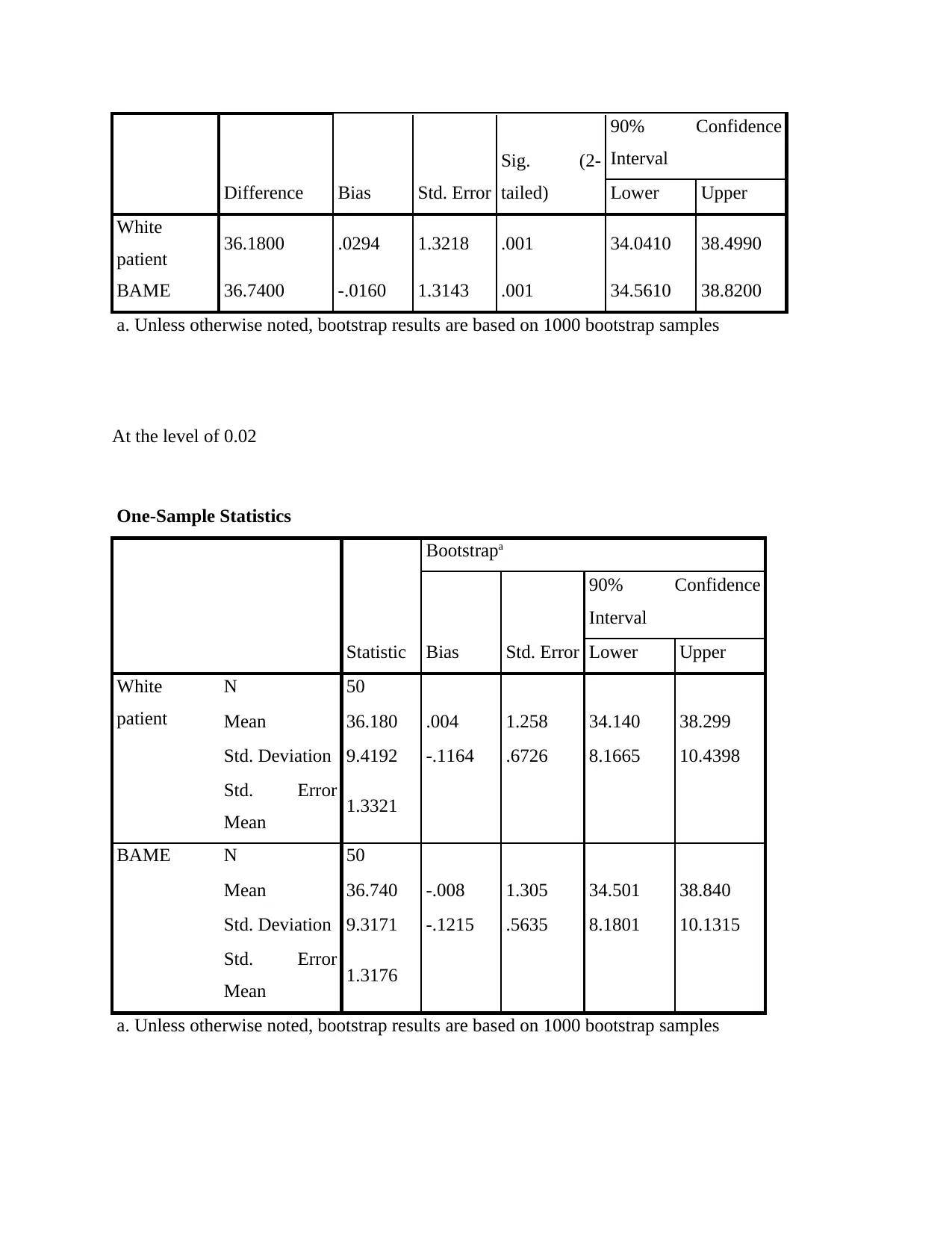
Difference Bias Std. Error
Sig. (2-
tailed)
90% Confidence
Interval
Lower Upper
White
patient 36.1800 .0294 1.3218 .001 34.0410 38.4990
BAME 36.7400 -.0160 1.3143 .001 34.5610 38.8200
a. Unless otherwise noted, bootstrap results are based on 1000 bootstrap samples
At the level of 0.02
One-Sample Statistics
Statistic
Bootstrapa
Bias Std. Error
90% Confidence
Interval
Lower Upper
White
patient
N 50
Mean 36.180 .004 1.258 34.140 38.299
Std. Deviation 9.4192 -.1164 .6726 8.1665 10.4398
Std. Error
Mean 1.3321
BAME N 50
Mean 36.740 -.008 1.305 34.501 38.840
Std. Deviation 9.3171 -.1215 .5635 8.1801 10.1315
Std. Error
Mean 1.3176
a. Unless otherwise noted, bootstrap results are based on 1000 bootstrap samples
Sig. (2-
tailed)
90% Confidence
Interval
Lower Upper
White
patient 36.1800 .0294 1.3218 .001 34.0410 38.4990
BAME 36.7400 -.0160 1.3143 .001 34.5610 38.8200
a. Unless otherwise noted, bootstrap results are based on 1000 bootstrap samples
At the level of 0.02
One-Sample Statistics
Statistic
Bootstrapa
Bias Std. Error
90% Confidence
Interval
Lower Upper
White
patient
N 50
Mean 36.180 .004 1.258 34.140 38.299
Std. Deviation 9.4192 -.1164 .6726 8.1665 10.4398
Std. Error
Mean 1.3321
BAME N 50
Mean 36.740 -.008 1.305 34.501 38.840
Std. Deviation 9.3171 -.1215 .5635 8.1801 10.1315
Std. Error
Mean 1.3176
a. Unless otherwise noted, bootstrap results are based on 1000 bootstrap samples
⊘ This is a preview!⊘
Do you want full access?
Subscribe today to unlock all pages.

Trusted by 1+ million students worldwide
1 out of 16